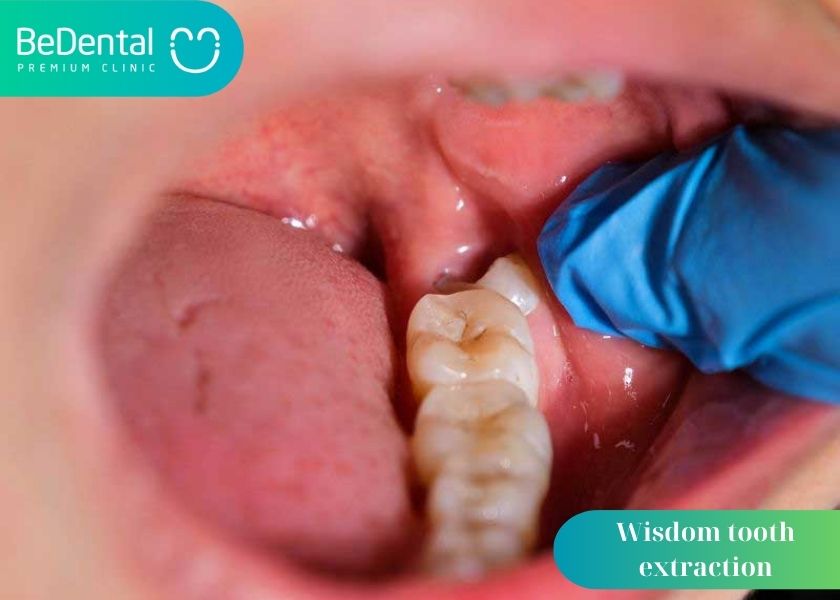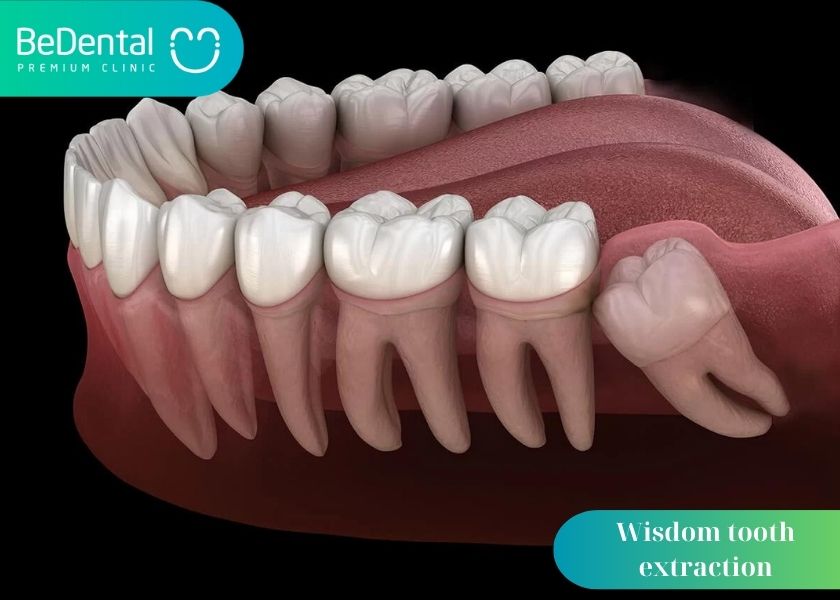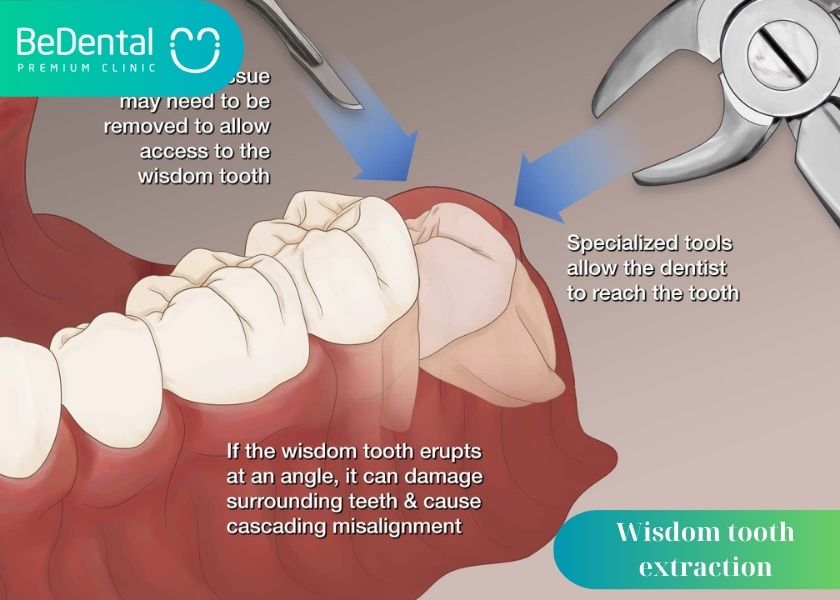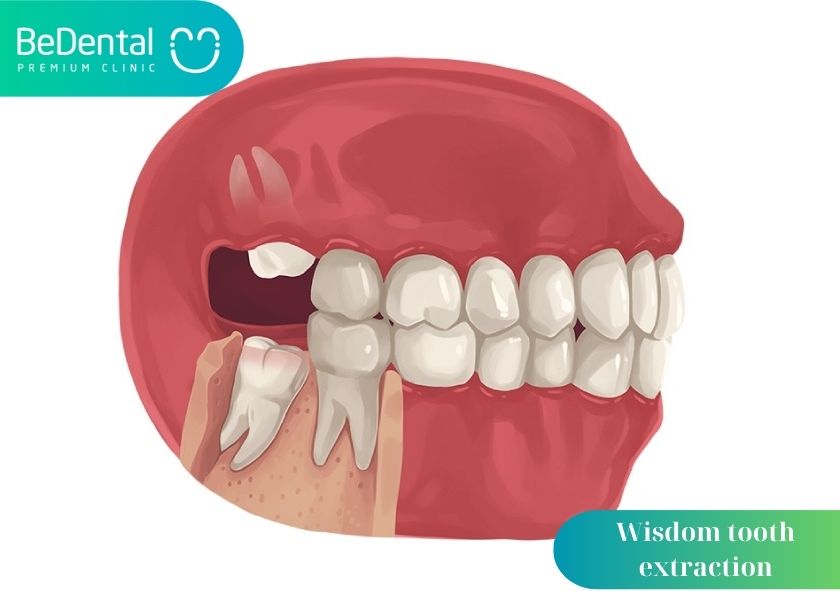Is it really dangerous if wisdom teeth are not fully extracted? This is also a concern for many people. So, is it dangerous to have roots of wisdom teeth left behind? Is it as dangerous as many people think? To provide a more comprehensive understanding, let’s read through this article together with BeDental!
Reasons for incomplete extraction of wisdom teeth are not fully extracted
1. Intentional decision by the dentist

Whether or not to remove the roots of wisdom teeth along with the wisdom teeth themselves is a decision that dental professionals consider before performing the procedure for the patient. Depending on each individual’s circumstances and the condition of the wisdom teeth, dentists will decide whether or not to completely remove the roots of the wisdom teeth at the same time as the wisdom teeth. Typically, dentists will retain the roots of the wisdom teeth in the following cases:
- If complete removal of both the wisdom teeth and their roots could lead to complications and affect oral health, such as damage to gum tissue, excessive bleeding from the roots, or impact on nerves causing numbness in the jaw.
- When the roots of the wisdom teeth are deformed, have inflammation, infection, or swelling. Dentists will limit the complete removal of the roots of the wisdom teeth in these cases to avoid worsening the condition and affecting the nerves.
2. Lack of skill by the dentist:
Not all dentists can guarantee the complete and safe removal of wisdom teeth. In cases where the extraction of wisdom teeth is difficult, such as when the teeth are impacted or growing horizontally inside the jawbone, it requires high technical skills and flexible handling. If not done properly, it can cause many complications and dangerous effects on the patient’s overall health.
Therefore, if the dentist lacks the necessary expertise and experience, it will be difficult to ensure the thorough removal of wisdom teeth and ensure the safety of the patient.
3. Unsafe machinery and equipment:
The process of removing wisdom teeth is not simple, as it requires dentists to have high skills and the machinery and equipment used must be modern, safe, and reliable. These are important factors that help minimize injuries and pain for the patient during the surgical process and ensure a quick and safe extraction of the tooth roots.
Therefore, the machinery and equipment used in dental clinics are one of the factors that guarantee safety during the surgical procedures. The use of outdated, low-quality, or insufficient equipment for the extraction process can cause difficulties and limitations in the thorough removal of wisdom teeth. This increases the risk of leaving behind tooth roots after wisdom tooth extraction and the risk of infection and inflammation in the surgical area.
4. Leftover tooth roots do not cause any harm to the patient:
If there are no abnormal signs such as prolonged pain or infection, it means that your tooth roots are clean and they will gradually recede into the jawbone and gum. Therefore, you do not need to remove them immediately. Monitor the progress of the tooth roots and wait until they emerge from the gum. At this point, the wounds have healed and there is no longer any danger, so you can visit a reputable dental clinic to have them removed.

How to know if you still have leftover tooth roots after wisdom tooth extraction
How to know if you still have leftover tooth roots after wisdom tooth extraction? Before performing a wisdom tooth extraction for a patient, dentists carefully examine the condition and results of the patient’s screening examinations to determine the appropriate approach and method for the extraction. Therefore, except for wisdom teeth that the dentist has indicated to be retained, in other situations, to determine if your tooth roots have been completely removed, you can rely on any abnormalities after the extraction, such as:
Counting the number of roots:
By examining the number of roots during the extraction of wisdom teeth and the screening process beforehand, if the number is lower, it means that the wisdom teeth have not been completely removed. Usually, after the extraction, the dentist will examine the condition of the extracted tooth, and if any situation occurs, the dentist will inform you and proceed with the next treatment process.
Monitoring post-extraction health:
After the extraction of wisdom teeth, it is normal to experience discomfort and pain. However, if this condition lasts for more than 2-3 days and worsens instead of improving, it is highly possible that the tooth roots have been left behind after the extraction. In this situation, it is advisable to see a dentist as soon as possible for further examination.
Reviewing X-ray films:
In some reputable dental clinics, after the extraction of wisdom teeth, patients may undergo X-ray examination to re-evaluate the condition of their oral health. X-ray films will help you clearly observe and assess the condition of the jaw and teeth after the extraction of wisdom teeth. Based on these X-ray results, you can easily determine whether or not you have left behind tooth roots after the extraction, and the dentists will provide the appropriate solution in such cases.

Is it dangerous to have roots of wisdom teeth left behind after wisdom tooth extraction?
This is also a question that many people are concerned about when it comes to wisdom tooth extraction or in unfortunate cases.
Depending on each patient’s case, the dentist will consider whether to retain the leftover tooth roots or not. In some cases, the decision to retain the wisdom tooth after extraction is intentional by the dentist. It may be because the wisdom tooth is in a difficult position to remove, or the extraction process is complex, requiring a longer time to completely remove both the wisdom tooth and its roots.
Therefore, you can rest assured and continue following your dentist’s examination schedule and rely on the examination results for the dentist to make further decisions on whether it is best to completely remove the tooth roots or retain them for you.
However, for the remaining cases, when there are leftover tooth roots without the dentist’s recommendation, it could be due to the dentist’s skill or technical errors with the equipment, which can result in incomplete removal of the wisdom tooth. In this situation, having leftover tooth roots can cause complications that affect our health.
Specifically, it can cause pain, swelling, and discomfort. The leftover tooth roots can also affect the oral hygiene process, providing an opportunity for bacteria to grow and leading to the formation of infected and inflamed areas. If this condition persists, it can not only affect the teeth and jaw but also have serious implications for the patient’s overall health.
Therefore, to avoid unfortunate situations, it is important to have clear communication with your dentist regarding the issue of leftover tooth roots after wisdom tooth extraction. If it is the dentist’s recommendation, it is not a significant problem. However, if it is not recommended by the dentist, it is best to consult with them to address the issue as soon as possible to avoid potential complications.

What to do when there are leftover tooth roots after wisdom tooth extraction
If you discover leftover tooth roots after wisdom tooth extraction, quickly contact a highly skilled dentist to help reassess the situation and provide timely solutions. During this time, you should avoid touching the area with your tongue or any other form of contact, especially trying to remove or touch the gum to extract the tooth roots, as this can affect the healing wound and lead to bleeding or infection.
Some ways to address the issue of leftover tooth roots after extraction are:
- Contact your dentist: First, contact your dentist to inform them of the situation. They will evaluate and determine whether you need to come in to remove the remaining portion of the wisdom tooth or not.
- Examination and X-ray: The dentist will examine the affected area and may request an X-ray to assess the condition and location of the leftover tooth roots.
- Decision on treatment: Based on the examination and X-ray results, the dentist will make a decision on the best course of action. This may include performing a minor surgical procedure to remove the remaining portion of the wisdom tooth.
- Monitoring and post-operative care: After removing the leftover tooth roots, you need to follow the dentist’s post-operative care instructions. This may include using pain medication and antibacterial mouthwash, avoiding strenuous activities, and adhering to oral care measures.
Cases where leftover tooth roots do not have any impact on the patient
If the remaining tooth roots do not cause severe pain or inflammation that affects the patient’s health, the dentist may not immediately remove them.
In this case, the dentist will need to monitor your overall health and oral condition. Wait until the tooth roots start to emerge slowly, no longer in a dangerous or difficult-to-remove position. The dentist will then proceed to completely remove the wisdom teeth for you.
Since the tooth roots have already erupted and are no longer in a difficult-to-remove position, the extraction process can be easier, quicker, and will not impact your health.
However, in reality, there are still many cases where the remaining wisdom teeth cannot be extracted by the dentist because they have a significant impact on the nerves. Therefore, the surgical removal will result in significant blood loss.

Cases where leftover tooth roots cause complications and impact
If the surgical site shows signs of inflammation, prolonged pain, and bleeding, it is necessary to address the remaining tooth roots as soon as possible. First, to limit infection and reduce swelling in the area, you should take antibiotics as prescribed by the dentist. Then, based on the actual situation, the dentist will determine the best time to remove the remaining tooth roots.
In cases where the failure to remove the remaining tooth roots leads to prolonged pain and inflammation for the patient, dentists will recommend immediate extraction to avoid further complications and potential risks to the patient’s health.
How are leftover tooth roots after wisdom tooth extraction handled?
This is also one of the questions about wisdom teeth that many people are concerned about. After having wisdom teeth extracted but realizing that there may be leftover tooth roots, patients will feel very worried and fearful. In this situation, many people would want to remove them immediately in any way possible to avoid consequences that can harm their teeth, jaw, and overall health.
However, the decision to completely remove wisdom tooth roots or not needs to be carefully considered as they can greatly affect the related nerves and gum tissue. Therefore, to decide whether to remove the tooth roots or not, a thorough examination and recommendation from a dentist is necessary to ensure the oral health of the patient. Accordingly, the extraction of wisdom teeth can be divided into two cases for consideration:
How to avoid leftover tooth roots after extraction?
Having leftover tooth roots after wisdom tooth extraction is a dangerous and troublesome issue for many patients if it is not recommended by a dentist. Therefore, to ensure the safe extraction of wisdom teeth without complications, the first thing to do is to choose a reputable, safe dental facility that provides the best services for wisdom tooth extraction.
This will be a place that provides excellent services with skilled dentists and uses safe equipment to ensure medical standards. One thing to note is that before extracting wisdom teeth, you should thoroughly research related issues to be able to easily discuss your concerns with the dentist.
See more: What to do if lose tooth number 7

| List | Unit | Price | |
|---|---|---|---|
| 1. Tooth Extraction (More detail...) | |||
| Deciduous tooth Extraction without anesthetic | 1 unit | ~ Free |
|
| Deciduous tooth Extraction with Anesthetic | 1 unit | 150.000 ~ 6$ |
|
| Front Tooth Extraction | 1 unit | 1.000.000 ~ 39$ |
|
| Premolar tooth Extraction | 1 unit | 1.500.000 ~ 59$ |
|
| Molar tooth Extraction | 1 unit | 2.000.000 ~ 79$ |
|
| Upper Wisdom Tooth Extraction | 1 unit | 1.500.000 ~ 59$ |
|
| Lower Wisdom Tooth Extraction Straight-grown | 1 unit | 2.000.000 ~ 79$ |
|
| Lower Wisdom Tooth Extraction non Straight-grown | 1 unit | 3.000.000 ~ 118$ |
|
| Lower Wisdom Tooth Extraction - Dificult | 1 unit | 4.000.000 ~ 157$ |
|
| Upper Wisdom Tooth Extraction with Piezotime | 1 unit | 2.000.000 ~ 79$ |
|
| Lower Wisdom Tooth Extraction Straight-grown with Piezotome | 1 unit | 3.500.000 ~ 138$ |
|
| Lower Wisdom Tooth Extraction Straight-grown with Piezotome - Dificult Case | 1 unit | 5.000.000 ~ 196$ |
|
| Lower Wisdom Tooth Extraction non Straight-grown with Piezotome | 1 unit | 4.500.000 ~ 177$ |
|
| Tooth abscess Treatment | 1 unit | 800.000 ~ 31$ |
|
| Tooth follicles treatment | 1 unit | 2.000.000 ~ 79$ |
|
| 2. Gum contouring Surgery (More detail...) | |||
| Gum contouring Surgery with Knife surgery | 1 unit | 500.000 ~ 20$ |
|
| Gum contouring Surgery with laser machine | 1 unit | 1.000.000 ~ 39$ |
|
| Gum contouring Surgery bone impacting | 1 jaw | 15.000.000 ~ 589$ | |
| 3. Other Surgery |
Tư vấn chuyên môn bài viết:
BÁC SĨ DƯƠNG THỊ THÙY NGA
BEDENTAL - TOP STANDARD DENTISTRY SYSTEM
In HANOI
Address 1: 7B Thi Sach St, Ngo Thi Nham, Hai Ba Trung Dist, Ha Noi. - 0934.61.9090
Address 2: No 129 Hoang Ngan, Yen Hoa, Cau Giay Dist, Ha Noi. - 0934.61.9090
In HO CHI MINH
Address 1: 53 -55 -57 Pho Duc Chinh St, Nguyen Thai Binh, Dist. 1, Ho Chi Minh. - 0766.00.8080
Working: 9am - 8pm everyday
Website: https://bedental.vn/en/





